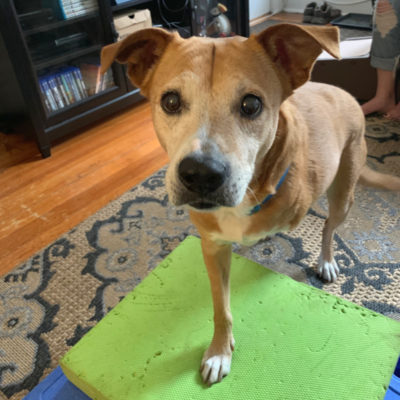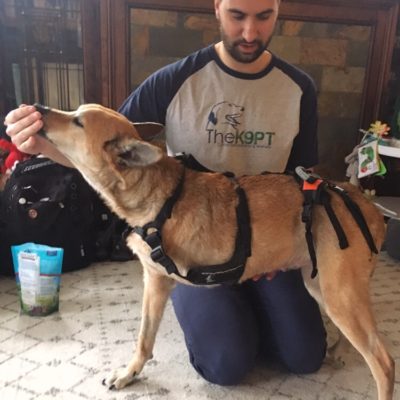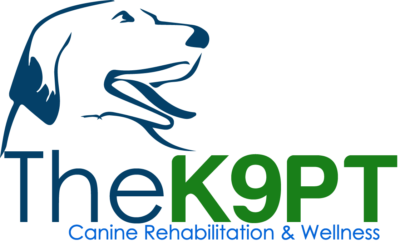From Four-Legged to Three-Legged: How Canine Rehabilitation Can Help Dogs with an Amputation
There is no reason why a pet with an amputation cannot live a long, happy, and healthy life—period! The idea of your precious pup needing a limb or part of a limb removed might be scary to think about, but the reality is that dogs are extremely adaptable. Whether the amputation is needed because of cancer, a wound complication, severe trauma, or a birth defect, generally the prognosis is very good for returning to a high level of function for the dog’s age.
Types of Amputations
Amputations may be recommended for either a front or hind limb, and as partial or complete. In the case of a complete amputation, which is most common, the affected limb is removed high up where the limb attaches to the body. In partial amputations, only a segment of the limb is removed, leaving a stump that requires daily care to ensure proper skin protection. Prosthetics are usually recommended in this case as the remaining portion of the limb may become injured during daily activities or impede normal movement.
Being able to choose between partial and complete may be an option; talk to your veterinarian to see which will be best for your dog.

What to Expect
Most dogs are discharged within one week of the surgery and sent home with pain medication and sometimes antibiotics. To prevent interference with the incision site, dogs should wear an E-collar for 10–14 days.
Once at home, they should be kept in a comfortable and safe environment for the first 24 to 48 hours without access to stairs or slippery floors. A sling can be used to assist your pet with rising and maintaining balance, but rigorous activity should be avoided for about four weeks or longer, depending on the dog’s general health and prior level of activity. Your dog may participate, however, in an exercise program designed to improve balance and strength for better standing and walking on three legs, or using a prosthetic.
Normal mobility is more easily achievable for hind limb amputees versus front limb amputees as the latter must make a larger adjustment to their gait. Either way, most dogs will be able to get back to normal mobility; some just need more time than others.

How a Canine Physical Therapist Can Help
A certified canine rehabilitation therapist is specially trained in how to optimize movement and minimize pain for dogs. This applies not only to your dog’s functioning within weeks after surgery but also to your dog’s health for life! A canine rehab therapist can teach you several things, including the following:
- How to help your dog perform home exercises to maintain balance, mobility, and strength
- How to properly inspect and care for the skin in the case of partial limb amputations
- How to perform gentle massage techniques for overworked muscles to keep your pup as comfortable as possible, especially on more active days
And these are just a few of the numerous ways in which they can help your dog adapt to and live their best life!
Special Equipment
Using a harness to help your dog get around, such as when getting in and out of a car or going up and down stairs, may be helpful in the first few weeks after surgery, and possibly longer depending on his or her age and general health. For high-quality harnesses that are made for lifting and assisting with the dog’s comfort in mind, be sure to check out Ruffwear and Help ‘Em Up harness systems.
While it is uncommon, some dogs who undergo amputations who have or develop severe arthritis or another condition that affects mobility may require the use of a doggy wheelchair. Similar to walkers for humans, doggy wheelchairs can provide much-needed balance support to make daily walks less of a chore and more enjoyable.

A limb amputation for your pup will require a bit of an adjustment for both you and your pup, but by no means does the fun have to stop just because of a change to one leg, or even two. Don’t hesitate to reach out to a certified canine rehab therapist, especially to stay on top of other musculoskeletal issues as with an amputation the joints of the remaining limbs must compensate for the extra load, which can lead to chronic issues if not addressed early on. (Hint: Keeping your dog’s weight under control will help to prevent accelerated wear and tear on the joints!)
The best thing you can do for your pup with an amputation is to keep a positive attitude and know that an active life is plenty possible. Dogs adapt pretty quickly—we could learn a lot from them!
~TheK9PT
Dr. Francisco Maia, PT, DPT, CCRT
In collaboration with:
Dr. Aliya Bahjet, PT, DPT
Professional Writer and Physical Therapist
